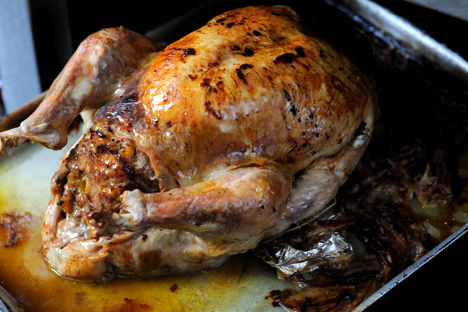Originally from America, where turkey remains synonymous with Thanksgiving, early European settlers incorrectly identified this big bird as guinea fowl. We now know differently, of course, and turkey is one of the leanest and nutritious meats to grace our dinner plates.
While turkey is arguably more flavourful and healthier than chicken, it hasn’t captured the British public’s tastebuds in the same way as it has in America, where it’s very popular. But substitute turkey for chicken in any recipe and you won’t be disappointed: it's brilliant as a Kyiv, in curries of all kinds, soups, salads, stir-fries or deep-fried in burgers. And of course, for many people, Christmas simply wouldn't be Christmas without a gargantuan turkey in the centre of the dinner table.
What to look for when buying turkey
Free-range, organic and high-welfare turkeys are always going to taste better (as well as being more ethical and environmentally friendly), so in our opinion they're definitely worth the higher price. Some of the bigger names – Kelly Bronze, Copas or Norfolk Black, for example – are generally regarded as the best turkeys you can buy, and should ensure top quality. Outside of the festive season it can be tough to find fresh whole turkeys (if you're after one then you'll probably have to order one from a butcher), but turkey escalopes, mince and frozen whole birds should be more readily available.
How to cook turkey
Don't just turn to turkey at Christmas – they’re ideal roasting birds if you’re cooking for a crowd, regardless of the time of year. As with all meats, you must rest the bird for at least 20 minutes before serving, and for juiciest results, baste well throughout cooking. As with chicken, turkey mustn't be fully cooked – juices should run clear when a skewer is inserted in the thickest part of the thigh (or it should reach an internal temperature of 74°C after resting).
The bird comprises of white meat (the crown) and dark meat (the thighs and legs). The white meat is healthier but much more prone to drying out; cooking it sous vide or rolling and stuffing are good methods to ensure you have moist, succulent meat. The dark meat benefits from a longer, slower cook, such as pot-roasting or braising.
The best way to roast turkey is a hotly debated topic, but it really comes down to personal preference. We prefer brining to ensure a particularly moist finish. Check out our brining guide here to learn more.
Turkey mince and escalopes are incredibly lean and make a fantastic base for other flavours, particularly in sauces (such as chilli) or when dry-rubbed with spices.
One of the quickest ways to eat turkey is to pan-fry the breast, or dice or mince the meat and add to a stir-fry. Stuffing or breading the breast will add flavour and moisture.
To add more flavour before pan-frying or roasting, marinate the turkey overnight, or cut a pocket into the flesh, stuff it with herbs and butter and wrap with bacon or pancetta before baking. Because it is a very lean meat, added fat is almost always added for extra flavour, a rich finish and to prevent a dry texture. Poaching or steaming delicate white meat, however, can make it superbly tender and juicy and both processes don’t require fat, so they’re healthy ways to cook. It’s important that the water or stock remains below boiling point – too hot and it will adversely affect the texture of the meat. How long it takes depends on the cut of meat and the recipe, but neither method takes as long as roasting.
What turkey goes with
Turkey is one of the more versatile meats around. Traditionally, the bird is roasted and served with a variety of vegetables and roast potatoes, but it can be served in almost any recipe that calls for chicken.
It may be celebrated during the holiday season but turkey isn’t just for Christmas; it makes an excellent alternative to the usual Sunday roast, goes well in a sandwich and, because it’s so lean, makes a healthy replacement for beef – use minced turkey in your burgers, meatballs and Bolognese.
Punchy Asian flavours complement the relatively mild flavour of turkey (as with Andy Waters' Turkey larb) as do creamy or herby sauces. Turkey is also wonderful in salads, as demonstrated by Dominic Chapman's Turkey, chicory, stilton and walnut salad.
Get in touch
Please sign in or register to send a comment to Great British Chefs.



